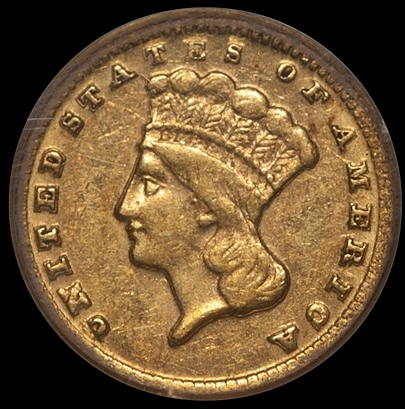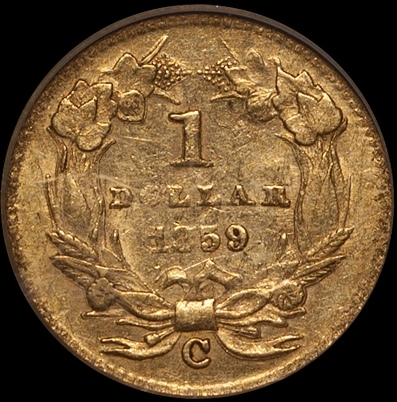1859-C G$1 AU53 认证号06621233, PCGS号7552
拥有者评论
CAC
专家评论
David Akers (1975/88)
Along with the 1857-C, the 1859-C ranks as the most consistently poorly struck gold dollar. The quality of the planchets used was also remarkably bad, and as a result, an 1859-C gold dollar, even one in high grade, always has a relatively unattractive appearance. Grading is difficult and one must take into consideration such factors as surface characteristics, mint lustre, etc. in order to accurately determine a grade. Even then, a certain amount of guesswork goes into the grading since it is difficult for even the expert to be able to say with assurance exactly what is wear and what is the result of a weak strike.Doug Winter
The 1859-C is the final gold dollar struck at the Charlotte Mint. It has the lowest mintage of any individual issue. At one time I believed it was the rarest collectible Charlotte gold dollar but a significant number of 1859-C gold dollars have been offered for sale in the past five to ten years, both in auction and via private treaty. In fact, enough higher grade 1859-C gold dollars have become available in recent years that I wonder if a small hoard was discovered and released into the market.In terms of overall rarity, the 1859-C is the more difficult of the two Charlotte gold dollars which employ the Type Three design. But it is actually less rare that the 1857-C in AU55 and above. It seems that this date is now more plentiful in relatively high grades than it was in the past. This may be the result of relaxed grading standards or the result of a small hoard coming on the market in the past five to ten years. Properly graded Uncirculated examples remain very rare.
STRIKE: The 1859-C rivals the 1855-C as the worst struck gold dollar from this mint. The 1859-C is always found with a very weak obverse. The hair is soft with only a few of the individual strands showing definition. The plumes are extremely flat while the feathers in the headdress show slightly better detail. The border is wider than on the other Charlotte gold dollars and its appearance more closely resembles a Dahlonega gold dollar of this era. The denticles are sharp from 12:00 to 3:00 but they tend to be weak or indistinguishable at the rest of the border. The reverse is poorly struck as well. The central detail is not as clearly defined as is the wreath. The date and OLL in DOLLAR are very weak as well. The reverse denticles are very weak and on many 1859-C gold dollars they are not visible at all.
The poor strike of this date makes it extremely hard to grade. At one time, examples with very little wear were assigned low grades because viewers confused the weakness of the strike described above with actual wear. Today, the exact opposite tends to be true. Many 1859-C dollars are overgraded because the grading services overcompensate for the poor strike seen on this date.
SURFACES: Most of the planchet problems described for the 1857-C gold dollar are also seen on the 1859-C. This includes mint-made imperfections such as chips and splits in the planchet. The typical piece is very grainy with the appearance of a seawater coin. A very small number are known with superior quality surfaces and these deserve to command a premium over their counterparts.
LUSTER: The luster is below average. The texture seen on many 1859-C gold dollars is lightly frosty with a strong amount of graininess. This is an extremely hard date to locate with original surfaces...
COLORATION: The few original, uncleaned 1859-C gold dollars that remain have medium to deep green-gold coloration. The recolored examples I have seen...tend to have very unnatural bright orange-gold or reddish-gold hues.
EYE APPEAL: Most 1859-C gold dollars have terrible eye appeal. They are very poorly struck, have detracting mint-made planchet problems and have been cleaned at one time. An example that is well struck, original and free of planchet problems (if it even exists) should sell for a significant premium over a typical one.
DIE CHARACTERISTICS: On the obverse, many of the letters are sharply doubled. On the reverse, the O in DOLLAR is smaller that the other letters and it is completely filled.
DIE VARIETIES: There is a single variety known.
Variety 1 (formerly Variety 11-N): The lettering is very heavy. It appears larger in size than on the 1857-C and it also shows considerable doubling. The date is small and evenly spaced. The mintmark is very large and placed high in the field near the bow knot.
PCGS #
7552
设计师
James Barton Longacre
边缘
Reeded
直径
14.30 毫米
重量
1.70 克
铸币数量
5235
金属成分
90% Gold, 10% Copper
更高评级数量
64
评级较低的钱币数量
37
地区
The United States of America
价格指南
PCGS 数量报告
拍卖 - PCGS 评级的
拍卖 - NGC 评级的
稀有性和存量估计 了解更多
| 所有评级 | 125 |
| 60或以上 | 7 |
| 65或以上 | 0 |
| 所有评级 | R-7.7 |
| 60或以上 | R-9.6 |
| 65或以上 | R-10.1 |
| 所有评级 | 7 / 49 TIE |
| 60或以上 | 3 / 49 TIE |
| 65或以上 | 1 / 49 |
| 所有评级 | 10 / 81 TIE |
| 60或以上 | 6 / 81 TIE |
| 65或以上 | 1 / 81 |
状况普查 了解更多
| #1 MS63 PCGS grade |
| #1 MS63 PCGS grade |
| #1 MS63 PCGS grade |
|
#4 MS62 PCGS grade
American Numismatic Rarities 8/2006:1165, not sold |
| #4 MS62 PCGS grade |






















